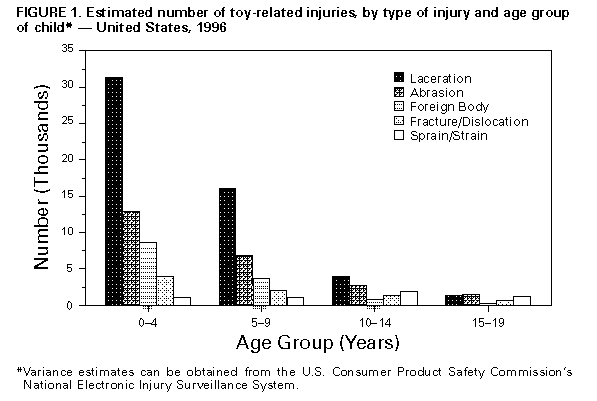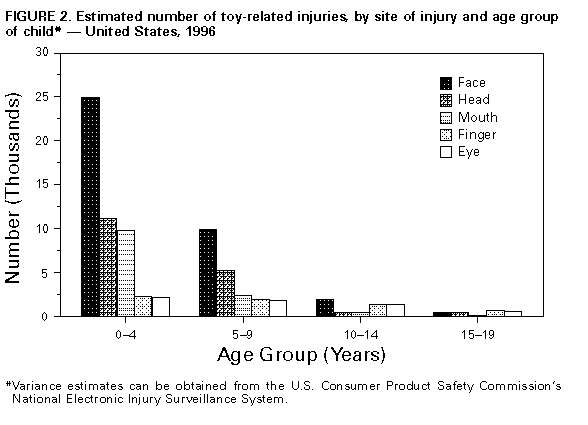 |
|
|
|
|
|
|
|
|
|
|
|
|
|
|
|
|
||||
| ||||||||||
|
|
|
|
Toy-Related Injuries Among Children and Teenagers -- United States, 1996Each year, approximately two billion toys and games are sold in the United States (1). Although most toys are safe when risks are measured against the frequency of their use, children are at risk for some toy-related injuries and deaths. To characterize the magnitude of this problem, CDC analyzed data from the U.S. Consumer Product Safety Commission (CPSC) for 1996. This report summarizes this analysis and underscores the importance of parental participation in the selection and use of toys. CPSC collects product-related injury data from numerous sources, including a probability sample of U.S. hospitals with a 24-hour emergency department (National Electronic Injury Surveillance System {NEISS}), Medical Examiner and Coroner Alert Program (MECAP), newspaper clippings, death certificate files, telephone reports, and other written and electronic correspondence (2). CDC analyzed these data to compile the frequency of toy-related injuries and deaths that occurred during 1996 among persons aged less than 20 years. Products included toys and games intended for use by children. During 1996, a total of 13 toy-related deaths among children were reported to CPSC (Table_1). An estimated 116,800 (95% confidence interval=98,500-135,100) nonfatal injuries requiring emergency department care were reported through NEISS. Of these, 76,000 (65%) occurred among males. Most cases (65,500 {56%}) involved children aged 0-4 years, followed by 33,500 (29%) among those aged 5-9 years, 12,000 (10%) among those aged 10-14 years, and 5800 (5%) among those aged 15-19 years. Most (approximately 45%) toy-related injuries were lacerations; injuries also included abrasions or contusions (21%), ingestion or lodging of a foreign body (12%), fractures or dislocations (7%), sprains or strains (5%), and miscellaneous injuries (10%) (Figure_1). Approximately two thirds of all injuries occurred above the neck and involved the face (32%), head (15%), mouth (11%), and eye (5%); fingers accounted for 5% of injuries (Figure_2). Approximately 1% of children injured were admitted to the hospital for further treatment. Reported by: Div of Unintentional Injury Prevention, National Center for Injury Prevention and Control, CDC. Editorial NoteEditorial Note: Children use toys for recreation, learning, exercise, psychosocial development, expression, and fantasy play. Most toys are designed, manufactured, and used safely. Surveillance for toy-related injuries and deaths can be useful to manufacturers, consumers, and persons who supervise use of toys. At least four strategies can be employed to prevent toy-related injuries (see box(Table_1B)). First, because children can be injured while using toys designed for an older child, children should use only toys that are age appropriate. Second, children should be directly supervised when playing with balloons, which result in seven to 10 deaths each year (2) (Table_1). Balloons should be stored out of reach of children, should not be inflated by children, and should be deflated and discarded after their use. An adult or competent adolescent should supervise activities when potentially dangerous household objects (e.g., sharp knives) are required for use with a toy (e.g., to build a model airplane). Third, because characteristics of the environment in which an age-appropriate toy is used may be associated with increased risk for injury, parents should ensure that toys are used in a safe and proper environment. Finally, because of the involvement of the head and face in toy-related injury, parents should be especially cautious when children are using projectile toys (e.g., dart guns). CPSC has developed manufacturing standards that address toy hazards, such as those associated with small parts, sharp points and edges, electronic components, pacifiers, rattles, lawn darts, clacker balls, caps, and toys containing lead-based paint (D. Tinsworth, Division of Hazard Analysis, CPSC, personal communication, 1997). In addition, the Child Safety Protection Act *, which was designed to reduce toy-related chokings, requires manufacturers to place small parts and choking hazard warning labels on balloons, marbles, small balls, and games with small parts intended for use only by children aged greater than or equal to 3 years. This act also requires manufacturers, importers, distributors, and retailers to notify CPSC about choking incidents involving such products. CPSC also monitors the manufacture and sale of toys in the United States. When toys fail to meet safety regulations or are associated with increased risk for injury, CPSC is authorized to take corrective action, including recalls and issuing public warnings (3). From 1995 through 1997, CPSC issued 310 recalls and corrective actions for toys that violated mandatory safety standards or that presented substantial product hazards. Although governmental regulation has been useful in protecting children from toy-related injuries, parents and caregivers are primarily responsible for ensuring the safety of children. Parents and other caregivers can prevent toy-related injuries by making informed decisions about the correct type of toy to buy and periodically monitoring children's use of toys to ensure that toys are being used safely. Additional information about the safety of toys and corrective actions is available from CPSC, telephone (800) 638-2772; or on the World Wide Web, http://www.cpsc.gov/ cpscpub/prerel/prerel.html. References
* Public Law 103-267, 1994. Table_1 Note: To print large tables and graphs users may have to change their printer settings to landscape and use a small font size.
TABLE 1. Case descriptions of toy-associated fatalities, by toy, age and sex of decedent,
and location of incident -- United States, 1996
============================================================================================
Toy/Age Location
of child (yrs) Sex of incident Description of injury
------------------------------------------------------------------------------------------
Balloons
1 M Home Choked on balloons in his mouth while waiting
for older sibling to inflate them.
2 F Home Choked on balloon she was chewing.
2 F Home Choked during loss of balance while balloon
was in mouth.
2 F Unknown Choked on a balloon.
3 M Inside Choked on balloon during birthday party.
5 M Home Aspirated a balloon.
11 M Outside Choked while swallowing a balloon he was
chewing.
Tricycles
2 M Outside Rode tricycle through open gate into a pool.
3 M Outside Rode tricycle into an in-ground pool and
drowned.
Miscellaneous
1 M Home Choked on one-fourth-inch plastic bead.
2 F Home Choked on piece of plastic while in crib.
2 M Home Aspirated three-fourths-inch plastic toy part into
lung.
6 M Outside Strangled by kite string hanging on a tree
branch.
------------------------------------------------------------------------------------------
Source: U.S. Consumer product Safety Commission Death Certificate, In-Depth Investigation,
and Reported Incident Files, 1996.
============================================================================================
Return to top. Figure_1  Return to top. Figure_2  Return to top. Table_1B Note: To print large tables and graphs users may have to change their printer settings to landscape and use a small font size.
General Recommendations for Children's Safety with Toys
=============================================================================
Toy Purchases:
1) Parents should check age and safety-related warnings on toys and
strictly adhere to them, especially when buying for small children.
Because risk for injury relates to the child's physical size or
strength, age warnings address chronologic rather than developmental
age.
2) Parents should select toys that match the abilities, skill, and
interest level of the child.
3) Parents of children who mouth objects should avoid buying toys that
have small parts or that may break into small parts.
4) Parents of children aged <8 years should not buy toys with sharp edges,
points, or heating elements.
5) Purchases should take into consideration all children at home, not just
the child for whom the toy is intended. Toys intended for older
children should be stored out of reach of younger children.
---------------------------------------------------------------------------
Toy use:
1) Play is safer when adults are involved than when toys are given to
children and parents supervise from a distance.
2) Parents and caregivers should demonstrate proper play when a toy is
first used.
3) Parents should ensure that mobile toys are used in enclosed areas where
the risk for falling is small. Tricycles and riding toys should not be
used unsupervised near stairs, areas of traffic, or swimming pools.
4) Parents should teach children to put toys away after playing to prevent
falls.
5) Parents should check toys periodically for breakage and loose, small
parts, and such toys should be repaired or discarded.
6) Parents should periodically monitor children's play to check for
improper use of toys.
---------------------------------------------------------------------------
Source: U.S. Consumer Product Safety Commission.
=============================================================================
Return to top. Disclaimer All MMWR HTML versions of articles are electronic conversions from ASCII text into HTML. This conversion may have resulted in character translation or format errors in the HTML version. Users should not rely on this HTML document, but are referred to the electronic PDF version and/or the original MMWR paper copy for the official text, figures, and tables. An original paper copy of this issue can be obtained from the Superintendent of Documents, U.S. Government Printing Office (GPO), Washington, DC 20402-9371; telephone: (202) 512-1800. Contact GPO for current prices. **Questions or messages regarding errors in formatting should be addressed to mmwrq@cdc.gov.Page converted: 09/19/98 |
|||||||||
This page last reviewed 5/2/01
|